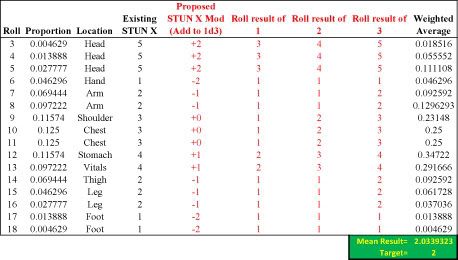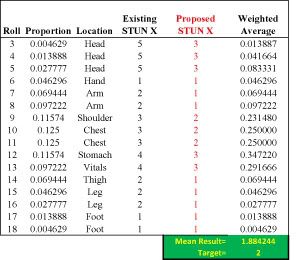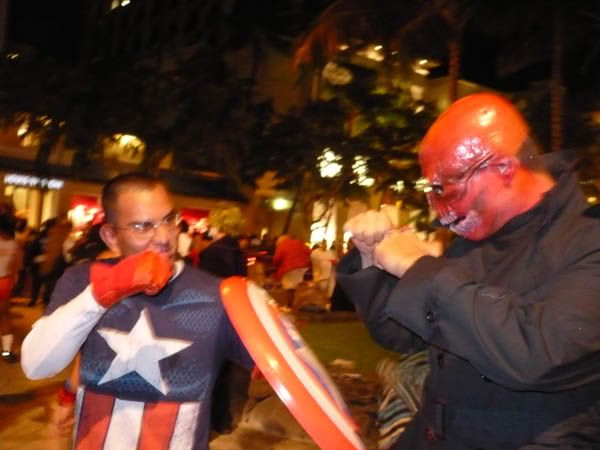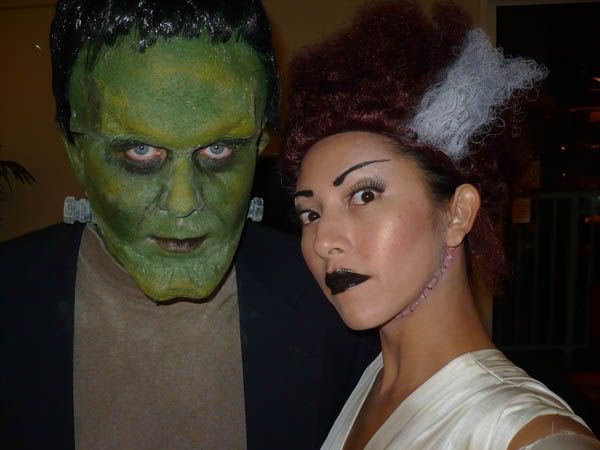-
Posts
1,038 -
Joined
-
Last visited
Content Type
Profiles
News
Store
Forums
Downloads
Events
Posts posted by etherio
-
-
Re: STUN multipliers in 6e
What I am saying is that with higher stun multiples' date=' opponents in heroic games tend to knocked unconscious. With a chart that halves stun multiples will cause people to fire more rounds into their opponents. Thereby causing more BODY damage in the combat and causing more deaths as a result.[/quote']Which is exactly in line with "cinematic realism" and is exactly what I'm trying to achieve. I have seen many players bemoan the fact that KAs tend to knock out their opponents in heroic scale campaigns rather than kill them. It creates a need to take prisoners in most battles (who may require medical attention) or to unheroically administer a coup de grace to unconscious or stunned opponents. Either case is awkward and inconvenient to a storyline. There are mentions in the rules books, in fact, as to how one might 'hand-wave' this away and consider such opponents killed to avoid that awkwardness. You're on the other side of that opinion. I get it. I'm not confused about your point. I understand what you're saying, game-mechanic-wise; I just don't identify with the sentiment behind your point.
In my opinion...in my campaign vision...it boils down to this: If you don't want to kill people, use non-lethal attacks. Like, for example, not shooting them with bullets...not stabbing them with swords.
As to a specific point you made: My chart doesn't halve STUN multipliers. It reduces the mean multiplier from a 2.8 to a 2.0...and maintains the same range and the same maximum results.
In any case, it's clear that you appreciate KAs doing more STUN in heroic games than in supers games...so enjoy the system as-is. I moved my topic and posted my ideas here intentionally for analysis, constructive criticism, and refinement by...or just to see the alternate ideas of...those who are interested in exploring ideas for house-ruling STUN damage for KAs to be more equivalent in hit-location and non-hit-location campaigns. I did so to stop derailing another person's chosen topic. If you'd like to debate that point, I suggest creating a thread to share your arguments on that topic.
-
Re: STUN multipliers in 6e
It isn't a complication. The modifiers on the chart are used in different ways because it is used for multiple different things. For killing attacks it is used to determine the base amount of Stun damage done by the attack. For a normal attack it is used to modify the already determined base amount of Stun damage done by the attack. It can't be done after defenses for KAs because before you apply the multiplier there isn't an amount of Stun damage to apply the defenses to.Yes, but I assume Sean meant that both could be multiplied BEFORE defenses. I don't necessarily agree that it would be a good idea, but his point remains.
-
Re: STUN multipliers in 6e
I think that the stun multiple is less noticeable in heroic games than supers games, but not less of an issue: if someone takes 9 Body then you probably don't feel so bad that they also took 36 stun, or 45 stun - there is a good chance they are dead anyway.The real issue with stun multiples occurs because of the interaction of damage and defences - and where resistant defence is low or non existent - far more likely in heroic games - that is less likely to be an obvious. It really shows up though in superheroic games where no body gets through but scads of stun do.
This has been 'fixed' in 6e with a low multiple - but I would say that the problem still very much exists in heroic games: it is just that Body damage tends to overshadow stun damage concerns.
100% agreed.
And in any case, why would someone want...in a fantasy or science fiction game for example...their bad guys to get knocked out by guns and swords? That's odd and certainly not in the spirit of cinematic realism. Do you have a big jail where you're keeping all of your stormtroopers?
-
Re: STUN multipliers in 6e
BTW on the original table the normal attacks stun mult is quite broken. It serves to nerf normal damage by a large amount. The published Hit location chart is like saying to folk who aren't using a KA "ok you have a 50% chance to do half damage and a 2% chance to do double damage. Have fun"This is actually not true. If you find the mean multiplier, weighted by the probability for each location, the mean multiplier is very, very close to 1.
-
Re: STUN multipliers in 6e
Because then all of the Heroic level games become VERY deadly suddenly. By not changing the Stun Mult on the Hit Location chart those old campaigns won't have to change drastically.Basically the Stun Lotto was a huge problem for Champions, and no so much an issue with Heroic games. Of course YMMV.
This is a change that I won't ever be using in my games.
I think you must be missing something. The methods I presented make KAs do less STUN damage...not more. And they have no impact on BODY damage. You might disagree about the need for it or my "fix," but the point you seem to be making is the opposite of the truth.
-
Re: STUN multipliers in 6e
Because Normal Attacks still can hit x2 Stun (assuming you don't change them). So using the first method given' date=' on a Head hit, a 6d6 normal attack has an average 42 Stun and a max of 72 Stun. A 2d6 Killing Attack will average only 21 Stun and max at 36 Stun on the same Head hit.[/quote']This is a point worth examining, which is why I prefer the second method that I presented. In that method, the range of STUN multipliers is the same as those on the chart as written. You can still achieve a X5 on the head. It's just not a foregone conclusion. The averages are just brought down a tad to be in line with the mean on a 1d3 roll.
On the chart as written, BODY and N STUN multipliers average the same as without the chart...1, in those cases...while the maximum results are doubled. My second system brings the KA STUN multiplier in line with the rest.
Also, remember that a multiplier on N STUN has a less-dramatic impact, because of the larger number of dice and resultant narrower distribution. You're much less likely to roll high damage than you are with an equivalent KA.
-
Re: Project XIII: images from my campaign
Good stuff (and appropriate beverage choice)' date=' but the folks behind you in the ghost costumes are especially impressive![/quote']heh. I got some comments to that effect on facebook, as well. You should've seen the folks over Mancer's left shoulder, though. That dude had his woman's skirt aaaaaall the way up, and she wasn't complaining a bit. Ah, Halloween in Waikiki...
-
Re: Post "gotchas" here
I posted my house rule ideas on the STUN multiplier topic on [thread=76404]this thread[/thread].
Sorry for the derailing, Chris!
-
Re: STUN multipliers in 6e
My preferred alternative (albeit slightly more complicated) includes ideas from Sean Waters and Chris Goodwin.
In order to maintain the variability of the die roll for the STUN multiplier and the increased damage range that the chart afforded, while keeping the mean STUN X at about 2, I put together the following system:
One still rolls the 1d3 STUN multiplier, but also adds a modifier to that roll from the chart. Of course, after any modifiers for Reduced STUN Multiplier, any result of less than 1 is treated as 1.
Below is an example of the hit location chart with the following edits and my data included:
- A STUN multiplier of 5 is replaced with a +2 mod
- A STUN multiplier of 4 is replaced with a +1 mod
- A STUN multiplier of 3 is replaced with a +0 mod
- A STUN multiplier of 2 is replaced with a -1 mod
- A STUN multiplier of 1 is replaced with a -2 mod
I weighted for probabilities of the different hit locations on a 3d6 distribution, as before, and I accounted for the minimum result of 1.
The mean result is 2.03...better than I had hoped. I think I may include this in my house rule repertoire.
Here's my method:

- A STUN multiplier of 5 is replaced with a +2 mod
-
Re: STUN multipliers in 6e
The simplest option is to edit the multipliers so that the mean result is closer to 2, which is the mean result for a 1d3. As it stands now, the chart averages at about 2.8, which is too large a dicrepancy for my tastes.
Below is an example of the hit location chart with the following edits and my data included:
- A STUN multiplier of 4 or 5 is replaced with a 3
- A STUN multiplier of 3 is replaced with a 2
- A STUN multiplier of 1 or 2 is replaced with a 1
I weighted for probabilities of the different hit locations on a 3d6 distribution.
The mean result is 1.88...much closer to a 2. Additionally, one could diverge from the pattern and give the 'thigh' location a 2, and the mean would be even closer...at about 1.95.
Here's my method:

- A STUN multiplier of 4 or 5 is replaced with a 3
-
Moved from another thread.
So I noticed that Steve nerfed STUN multipliers quite a bit in 6e, and I heartily approve. They are now a 1d3 (averaging 2, of course). However, he did not change the STUN X column on the optional hit location chart to reflect such. After some discussion on [thread=74928]another thread[/thread], I've concocted a house rule idea or two to (in my opinion) "fix" the problem and make the STUN damage for KAs on the hit location chart equivalent to those that do not use the chart.
My explanations and method follow. I'm not posting this for a debate on the merits of the rules as they stand...just sharing.
-
Re: Post "gotchas" here
Try this on for size: instead of a flat multiplier' date=' Hit Locations grant a bonus or penalty to rolled Stun Multiplier...[/quote']This looks like it might beautifully combine solutions to both the problem that Sean mentioned regarding the uniformity of STUN results and my issues. Chris, I think you have just inspired a new house rule for me. Gonna draft an idea and pitch it to my gang.
-
Re: Post "gotchas" here
...What I quite liked about it though was that in heroic games it means that killing attacks really are deadly: the fight does not stop because the opponent is in a swoon - it stops because their head is no longer attached to their body.Unfortunately Heroic games are where you are most likely to use hit locations - thereby neutralising the benefit of the new mechanic...
Exactly my point.
...What upsets me is therefore not the execution - I can live with it either way - but the fact that the opportunity to apply a principle has been lost' date=' or avoided.[/quote']Ditto. I can house-rule things to my satisfaction, as can we all. I was just surprised by what appeared to be a 'fix' being ignored entirely for hit locations. It puzzled me, considering the thought that must have gone into the 1d3 change...so I thought it may have been an oversight.
-
Re: Project XIII: images from my campaign
Heya Etherio ... this looks cool' date=' but do you have it at the full size?[/quote']Thanks, Sketchpad...I'd love to help, but I'm not sure what it is you're looking for. You should print the file at 7.5" by 9". If you're having trouble doing that, let me know what graphics programs you have, and maybe i can help you figure it out.
-
Re: Project XIII: images from my campaign
This was destined to happen.

-
Re: Project XIII: images from my campaign
Me and Mancer...
I was surprised at how many people (especially Japanese tourists) recognized the Red Skull.

-
Re: Project XIII: images from my campaign
New images and writeups of PCs for our present campaign coming a lil later in the day, but for now...
Halloween! We're like kids.
Me and the wife...

-
Re: Post "gotchas" here
...I'm not sure you and I are interpreting the 'Cannot Use Targeting' modifier the same. My reading of it is that your modifiers become x1 for both Body and Stun no matter what Hit Location you roll (or target). Now' date=' I could see the argument being made that you should apply a flat x3 Stun multiplier for Killing Attacks regardless of location but it's not explicit either way...[/quote']The debate at hand aside...I'm guessing that there aren't many here that share your interpretation on this particular point.
-
Re: Post "gotchas" here
...The real question when House Ruling' date=' in my mind, is how do KAs stack up against same DC normal attacks? If you're not using Hit Locs, then KAs do (a lot) less Stun on average but more Body. If you are using Hit Locs then KAs do less Stun on average but more Body. The roles of the two powers remains the same (you want to do Stun use a NA; you want to do Body use a KA)...[/quote']You demonstrate how the two powers are relatively differnt, and then state that they remain relatively the same.
-
Re: Post "gotchas" here
Normal attacks still average the same - pretty much - if you are using hit locations though - you just get more extreme results. KAs average very differently.Thank you, Sean. When using the hit location chart, the average multipliers for both the STUN and BODY of normal attacks are very, very close to 1. Normal attacks using the chart do equivalent damage to normal attacks without the chart. KAs, however, do significantly more STUN with the chart than they do without the chart.
There are two small game balance issues:
- KAs using the chart do a lot more stun damage than those that don't use the hit location chart. And yes, the game design anticipates that there will be those attacks that should not use the chart, even when your campaign uses it. Hence, the 'Cannot Use Targeting' limitation. Yes, I know it's a limitation, but it operates differently on KAs than on normal attacks, because...
- KAs in campaigns that use the chart will do more STUN damage relative to the normal attacks in the campaign, because the multiplier for normal attacks are better designed. KAs in your supers games, for example, will be weaker per DC than those in your heroic games.
So it wasn't an oversight. I get that. But that doesn't diminish my point. Because I hold Steve in such high regard as a game designer, I just assumed that he may have overlooked it. Perhaps had he been alerted to this particular point he may have made a different choice...perhaps not. The purposefulness of his choice, though, isn't relevant to my point.
- KAs using the chart do a lot more stun damage than those that don't use the hit location chart. And yes, the game design anticipates that there will be those attacks that should not use the chart, even when your campaign uses it. Hence, the 'Cannot Use Targeting' limitation. Yes, I know it's a limitation, but it operates differently on KAs than on normal attacks, because...
-
Re: Post "gotchas" here
Don't forget that Normal Attacks also operate more powerfully in campaigns with the Hit Locations chart as they can get a x2 Stun and Body multiplier that they can't get in campaigns without the HL chart.You can apply the same Limitation to Normal attacks as well.
I think that so long as one consistently applies the use of the Hit Locations chart, then parity between Normal and Killing attacks is pretty much maintained.
In a non Hit Locations game:
* Normal Attacks get no multpliers
* Killing Attacks have a 1-3 multiplier averaging 2.
* As a result, they have the same max Stun but lower min and average comparied to Normal Attacks, but they have higher average Body.
In a Hit Locations game:
* Normal Attacks get 1/2 to 2 multipliers for Stun and Body, averaging 1.
* Killing Attacks get 1/2 to 2 multipliers for Body, averaging 1, and 1-5 multipliers for Stun, averaging 2.87.
* The average, min and max Stun for Killing Attacks is lower than they are for Normal Attacks but the average Body is still higher.
Your analysis isn't accurate. I included a graphic with my methodology for analyzing the multipliers in a previous post. Using the hit location chart, normal attacks have a mean multiplier for both STUN and BODY damage that are almost exactly 1. Their effectiveness, outside of the ability to taget a location, is equivalent for both hit-location-using and non-hit-location-using attacks. KAs are different. Their average STUN multiplier is larger with the hit location chart than it is with the 1/2 d6 roll. My entire point is predicated on that fact. Some boards members here are okay with that in their games. I'd rather change it for my house rules. The numbers don't lie. The only relevant difference here is our levels of comfort with the disparity.
-
Re: Post "gotchas" here
First - Hit Locations are an Optional Rule, always have been. Within that consideration they aren't weighted the same as Core Rules.Second - a -1/2 Limitation is equivalent to a -2 Stun Multiplier. So if you must you can assume trading a possible 1-5 on KAs with Hit Locations you now have a 1-3 (given a Minimum StunX of 1). Which fits the 1D3 Model. Since you can only use the General Targeting Limitation in a Campaign using an Optional Rule of Hit Locations, I consider that fair.
Third - Making a Called Shot let's you attempt to get a higher StunX at the cost of an OCV penalty, another aspect I consider fair.
Fourth - This discussion probably could have been avoided entirely had you said "I'm looking for an alternative solution because I see an imbalance" instead of "It seems like an oversight to me" - because it wasn't. Or heck, "I don't like it, let's change it."
But your statement was entirely antagonistic in nature IMO. You essentially said "Bah! That has to be wrong! My view is obviously right! This is an oversight!" -

If you want an alterantive, drop the Head to x4, the Stomach/Vitals to x3, and possibly even the Shoulders to x1/2. Should even things up, but that's a rough guess and I've not bothered to actually do the math behind it.
If you honestly think that the phrase "seems like an oversight" is antagonistic, then you might want to switch to decaf.

For the record, my original statement was not meant antagonistically, nor was it meant to imply that my opinion is superior. It meant exactly what I said- that I thought it was an oversight...as in a very human mistake.
-
Re: Post "gotchas" here
They're definitely different. But the difference should be at the campaign level, not attack vs. attack -- in other words, one character isn't going to somehow be able to acquire an advantage over another by using the Hit Location Chart. They either all use the chart or they all use 1/2d6.Also, 1/2d6 is the "highly recommended default option" but room is left for the GM to use other options (1d6-1 is one listed).
It seems clear to me that changing to a 1/2d6 roll...not to mention the fact that normal defense now protects one from KA STUN... was meant to reduce the STUN for KAs. Keeping the hit location multipliers as they were (which generates STUN amounts equivalent to the old 1d6-1 multiplier) seems strange to me in light of the other changes. One might like the higher numbers, though, or might not have a problem with KAs operating more powerfully in heroic campaigns.
However, the issue doesn't end with simply choosing which shall be used in a campaign, because a campaign that uses hit locations can also very reasonably include KAs that do generalized damage instead, as in the case of the aforementioned 'Cannot Use Targeting' limitation, among other examples.
In those cases of generalized damage, KAs suffer a significant loss in power compared to equivalent normal attacks. To me, that represents a game-balance issue. My suggestions were meant for those who might agree and want to do more than hand-wave that discrepancy in their own games.
-
Re: Post "gotchas" here
It's not an oversight. It was left that way on purpose.If you're using the Hit Location Chart you don't use the Stun Multiple Die. If you're using the Stun Multiple Die you are, by definition, not using the Hit Location Chart. .
I doubt anyone here was confused about that. The question at hand is, 'Are they reasonably equivalent?' I, and some others, think that they aren't.
That's a Campaign Decision as Chris noted. No campaign should randomly use both at once.If you're making Called Shots - you can get a greater Stun Multiple at the cost of an OCV Penalty. That's also on purpose.
I never suggested that a campaign would "randomly" use both at once. That would be ridiculous. You've got an interesting predilection for making straw-man arguments.
I suggested...perfectly reasonably, IMHO...that both could appear in a campaign. There is even a limitation 'Cannot Use Targeting' for that express purpose. If they can both reasonably appear in a campaign, then they should be reasonably equivalent. I realize that one could argue that the limitation value might compensate for the decrease in STUN damage, but I'm guessing that it was designed to reflect the inability to get other benefits from targeting. The limitation did, after all, exist before 6e, and it's applicable to Normal attacks as well, which don't suffer from reduced damage from it in the same way that KAs do.
I did an analysis of the mean damage multipliers when using the hit location chart, and they reveal a disparity. I attached a graphic for those of you who'd like to see my data and methods.
For a 3d6 roll on the Hit Location table:
- Mean STUN X = 2.87
- Mean BODY X = .99
- Mean Normal STUN X= 1.00
For a 2d6+1 (High Shot) roll on the Hit Location table-
- Mean STUN X = 2.89
- Mean BODY X = .99
- Mean Normal STUN X= 1.00
These numbers always seemed to be adequately equivalent to the numbers you'd get when not using the chart. They're both very close to 1 on BODY and N STUN, and they are pretty close to the mean STUN X on a 1d6-1...which is 2.5. Additionally, the STUN X range is the same on the chart as it is on a 1d6-1 roll...1 to 5.
However, with the new 1/2 d6 roll for STUN X (which I wholeheartedly appreciate), the location chart multipliers for STUN are now a bit too different from the die roll. They average almost a full point higher, nearly equivalent to giving every weapon that uses it a +1 STUN Multiplier advantage (or conversely, those that don't a Reduced STUN Multiplier limitation). Additionally, their range is greater...1 to 5 as opposed to 1 to 3 that the die roll can provide.
I suggest one of the following (mutually exclusive) house-rule fixes for the sake of game balance:
- Reduce the multipliers across the chart so they have a mean closer to 2
- Allow KAs that 'Cannot Use Targeting' an additional -1/4, 'Uses 1/2 d6 for STUN Multiplier' (equivalent to 'Reduced STUN Multiplier')
I'm leaning toward the former. I have often felt in the past that STUN Multipliers needed a bit of nerfing. It also keeps the amount of KA STUN damage consistent between campaigns that do and do not use the hit location chart. (We do not use it for supers.)
- Mean STUN X = 2.87



STUN multipliers in 6e
in HERO System Discussion
Posted
Re: STUN multipliers in 6e